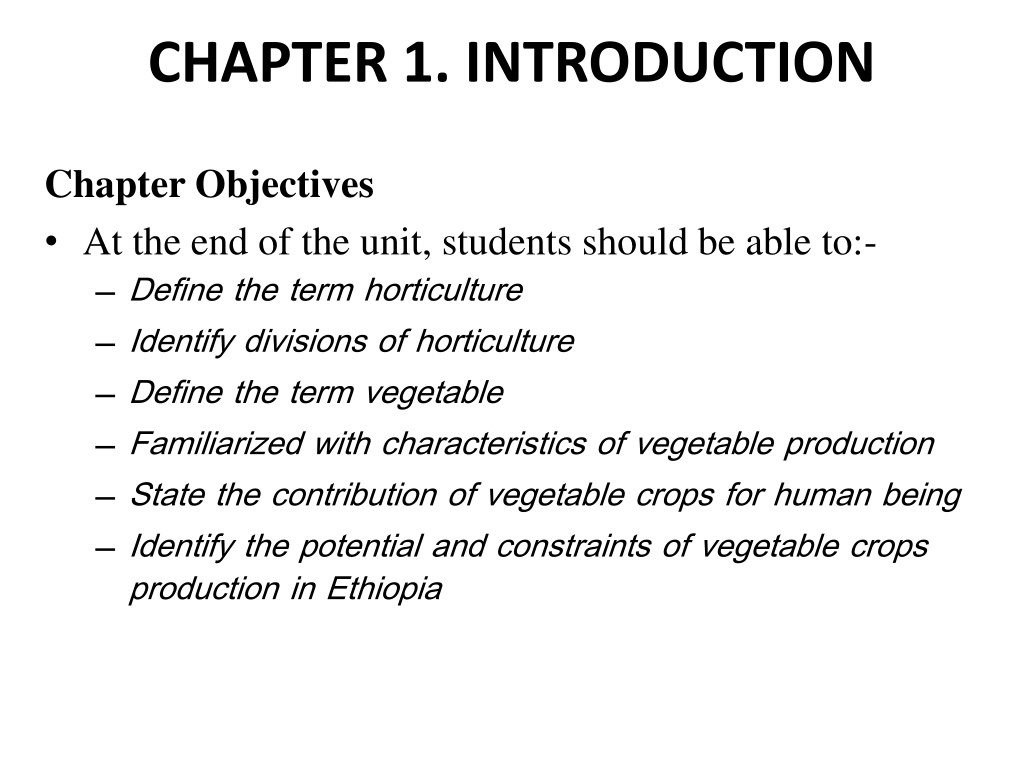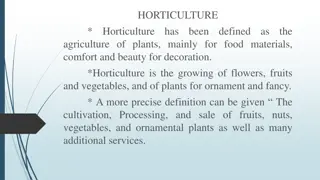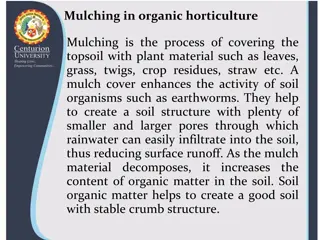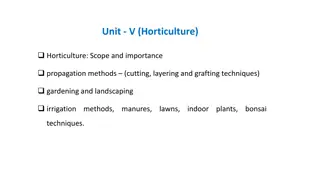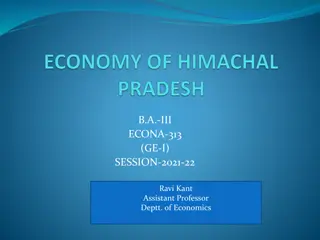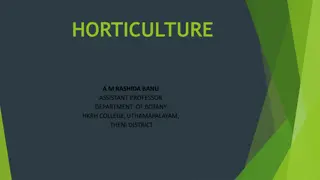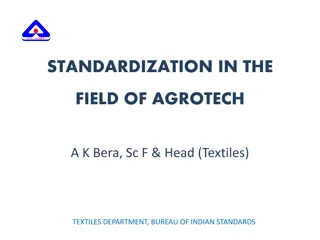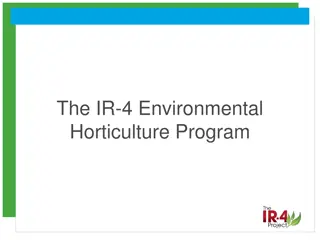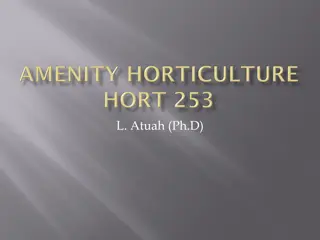Understanding Horticulture: An Introductory Overview
Horticulture, derived from Latin words meaning garden cultivation, encompasses the intensive production, utilization, and improvement of various crops for human consumption, medicinal purposes, and aesthetics. This chapter delves into the definition of horticulture, its major divisions, and the significance of vegetable crops in Ethiopia, offering insights into the potential and constraints of vegetable production.
Download Presentation

Please find below an Image/Link to download the presentation.
The content on the website is provided AS IS for your information and personal use only. It may not be sold, licensed, or shared on other websites without obtaining consent from the author. Download presentation by click this link. If you encounter any issues during the download, it is possible that the publisher has removed the file from their server.
E N D
Presentation Transcript
CHAPTER 1. INTRODUCTION Chapter Objectives At the end of the unit, students should be able to:- Define the term horticulture Identify divisions of horticulture Define the term vegetable Familiarized with characteristics of vegetable production State the contribution of vegetable crops for human being Identify the potential and constraints of vegetable crops production in Ethiopia
1.1. Definition Of Horticulture & Its Major Divisions Agriculture, is usually divided into two branches: Animal production. Crop & Again; crop production is usually divided into Horticulture, Agronomy, Soil science, Forestry & Crop protection.
The term Horticulture is derived from two Latin words, i.e. Hortus meaning garden & Cultra meaning cultivation. Thus, Horticulture literally means it is the cultivation of garden crops. In olden days Horticulture crops like fruits, vegetables, flowers were grown in the back yard of houses in an enclosure and in areas other than backyards in protected area by erecting walls, by raising live/non fences etc. i.e. they are enclosed.
As such the term Horticulture in the original sense; it referred to the cultivation of crops within the protected enclosure which is often called as a garden. So, the culture of crops in gardens is referred as Horticulture But at present times; Horticulture deals on cultivating, processing & sale of crops not only the fruits, vegetables & flowers but also other important crops like spices, condiments, plantation crops, medicinal & aromatic plants etc, & also which are grown not only with in the backyards/home garden, but also in large areas and quantities in open fields on a commercial scale.
Besides cultivation of these crops, present day Horticulture also deals with the utilization & improvement of these crops. Hence, modern horticulture is broadly defined as: A branch of agricultural science, which deals with An intensively production, Utilization & Improvement of fruits, vegetables, flowers, ornamentals, plantation crops, medicinal and aromatic plants etc which are directly used by man For food, Medicinal & Aesthetic purposes
Horticulture has two main goals: 1. To provide food for the society and 2. For environment beautification Unlike other crop production; Horticultural production involves Intensive cultural practices & Plants are usually given individual attention.
Generally, growing Horticultural plants is: More production, intensive than agronomy and forest plants Returns on investment per unit area of production are higher in Horticultural crops Horticultural plants are largely utilized fresh/living material whereas agronomic are not Horticulture is unique among plant sciences because it not only involves science & technology but it also incorporates art/principles of design.
Generally; Horticultural industry consists of 4 major divisions Pomology: It is derived from two Lain words i.e. Pomum meaning fruit & Logy meaning science or study. It is the science & practice of growing, harvesting, processing & marketing of tree fruits. Olericulture:- is the science & practice of growing, harvesting, processing and marketing of vegetables. Ornamental Horticulture:- deals with the science & practice of growing plants for aesthetic uses & improvement of quality of life & our environment like flowering plants, foliage plants, lawn grasses, evergreens & deciduous shrubs & trees etc...
Ornamental Horticulture can also classified as: Landscape Designing- is the use of ornamental plants in conjunction with other elements to beautify a given area or the environment aesthetically & make it more functional. It deals with artistic arrangement of plants in order to create picturesque & naturalistic effect in a limited space of land eg. recreational place like a park Floriculture:- It is derived from two words i.e. Florus meaning flower & Cultra meaning cultivation. It is the science & practice of growing, harvesting & marketing of flower crops (cut flowers, potted flowering and foliage) Turf culture: growing & study of turf grasses for lawns maintenance in different landscapes.
1.2. Definition & Characteristics of Vegetables Definition of vegetables Vegetables are a complex group of a wide variety of different types of plants. Some species grow from year to year; other grows and dies within one or two years. They have diverse forms of propagation; by seeds or vegetative parts. They may be herbaceous & Viny in growth habit.
They differ in growth requirements. Many vegetables can be grown under a wide range of conditions; While others have requirements that are more exacting for water, TOC & light. Thus in one place several species can be grown through the year, but there are others that can be grown only during certain times of the year. Irrigation is an absolute necessity for many species, but a few can be grown under rain fed conditions. Vegetables can grow in the wild or have to be cultivated. Distribution of species that are used as vegetables may be worldwide or limited to specific areas of certain regions
They can be produced in fields of specialized production areas, outskirts of urban areas, villages, or in gardens around the home. D/t parts of a plant may be used as a vegetable depending on the localities & culture. In general, developing countries utilize more parts of a particular plant as a vegetable than developed countries. Most vegetables are high in water content, which makes them bulky & highly perishable, particularly, the leaf ones.
Because of their diverse nature it is very difficult to come-up with a single, acceptable, all- encompassing definition of vegetables. Definitions of the word vegetable are generally based on their use. A vegetable could thus be defined as An edible, usually a succulent plant or a portion of it eaten with staples as main course or as supplementary food in cooked or raw form. So, any annual, biennial & perennial herbaceous plants and, edible fungus, if their succulent organs, such as leaves; it is considered as a vegetable
The term vegetables is usually used to designate the tender edible shoots, leaves, fruits and roots plants of plants that are eaten whole or in part, raw or cooked, as a supplement to starch foods meat. The term vegetable is applicable to the herbaceous plants or parts which are used for culinary purposes.
Notes-Vegetables are usually harvested when the plant is fresh & high in moisture & are thus distinguished from field crops which are harvested at the mature stage for their grains, pulses, oilseeds or fiber.
Characteristics of vegetable crops 1. Seasonality Most vegetables are seasonal. They grow best during certain seasons or in certain places. Several species of vegetables can be grown throughout the year but some others that can be grown only during certain times of the year. If irrigation is available, many species can be grown throughout the year.
2. Perishability Vegetables are usually harvested when the plant is fresh & it contain high moisture (85-90%) which makes handling, transport & storage, marketing a special problem particularly in tropics & are thus perishable crops although the shelf life of many root crops may extend over weeks. Deterioration is soon after harvest particularly the leafy salad crops. Thus they are distinguished from field crops, which are harvested at the mature dry stage.
3. High capital requirements Vegetables are intensively cultivated crops. Vegetable cultivation require intensive cultural practices and high financial and labor inputs involved are therefore greater than those needed for most staple food such as rice or maize.
4. Susceptibility to damage Crops only be stored for relatively short period of time and utilized mainly when they are fresh. Vegetable crops may also suffer from wind damage when grown on exposed sites where some form of protection will be desirable. For example, runner beans are susceptible for such damage.
5. Diversity Considering their diversity nature, a plant may be a vegetable in one country but a fruit, a weed, an ornamental or a medicinal plant in another country depending on the crop. For example, Tomato is a vegetable In Asia but a fruit in Europe. Although melons are generally used for dessert, they are considered as vegetable; since many members of the cucurbits family are vegetables.
In some cases, a plant could be a vegetable only at ascertains growth stage eg. bamboo is used for wood but the shoot is a vegetable. Some legumes can be used at various stages of development; the sprouted seeds, tender shoots, immature tender pods & and the mature seeds. Papaya & jackfruit are used as vegetable in south East Asia when they are immature. The garland chrysanthemum, is a vegetable to some Asians, to others, it is an ornamental.
They are also diverse in their edible portion. The edible portion can be: Leaf-eg. cabbage, lettuce, mustard, spinach, leek, parsley & celery (petiole), etc; Root- eg. carrot, radish, beetroot, etc; Stem/tuber/bulb-eg. bamboo shoot, asparagus, ginger, taro, potato, onion, garlic, Immature seed-eg. beans, sweet corn, etc; Immature fruit-eg. cucumber, eggplant, pepper, beans, pea, gourd, okra, chayote, etc; Mature fruit-eg. tomato, watermelon, etc; Flower bud-eg. cauliflower, broccoli.
6. Bulkiness They are bulky in relation to their volume and this is aggravated by the further needs of packing to protect them from damage. 7. Important in neutralizing acid Vegetables are important in neutralizing acid, which are produced in the digestion process of the heavy foodstuffs such as meat & cheese. Vegetables also provide variety to the diet & make meals more appetizing by giving more flavor, better appearance & zest to dishes.
8. Most of them are herbaceous/non-woody & also annuals Vegetables may be herbaceous, viny, shrubby, or tree in growth habit, but most of them are herbaceous. Production of vegetables does not involve a long-time investment as does in the orchard crops. Growing vegetables lacks stability; the land for production of vegetable crops is flexible and adjustable.
It is much easier for vegetable growers to change production from one crop to another than for fruit crop grower in one site. Thus, getting into vegetable production is a fast process and getting out may even be faster. Cooperative efforts and organizations are somewhat more difficult with vegetable crop producers than fruit growers. Vegetable/grower/farmers have no long period for making plans because of Vegetable production is seasonal due to most of it are annuals.
1.3. Prospects & Constraints of Vegetable Production in Ethiopia Prospects vegetable crops production in Ethiopia Vegetable crops make significant contributions to the Ethiopian household & national economy. It has many contribution to the country like Are valuable food security crops eg. Potato & sweet potato for densely populated highland regions & drought- prone areas, respectively & in general root & tuber crops are general high yielder- 40-60 tons per hectare and can provide food security especially in times of drought, famine & food shortages; highest yield of commonly grown teff, the staple food of the country, is on average 1 tonnes per hectare which is forty times less yield per hectare of potato (40 ton ha-1).
Are also used for flavoring local dishes and as well important as sources of vitamins and mineral eg. Hot pepper and onion. Help in balancing nutrition and protecting vulnerable groups of the local populations from disorders associated with low mineral and vitamin intake. Vegetable production is labor intensive and can generate 3 - 10 times the employment and income per hectare of land compared to that of cereals like maize. Vegetables also create a number of job opportunities in complementary businesses that arises such as marketing, processing and transportation. This offers an opportunity to absorb an ever- increasing unemployed labor force.
Vegetable has a huge potential to diversify export commodities and to earn foreign currency B/c of the above contribution & increment of urbanization, irrigation, some what research activities on vegetables & apple opportunity of the country to produce vegetables; The prospect/future of vegetables production is in Ethiopia is bright
Ethiopia have an immense potential for vegetable cultivation. These are: Favourable agro ecology (climate, soil & ample water supply both in RF and irrigation). Ethiopia has diverse agro-ecological zones or wide range of altitudes. This wide rage of altitude gives it a wide range of agro ecological diversity, where most vegetable crops can be successfully grown. Most region of the country are suitable for the production of a wide range of tropical, sub-tropical and temperate vegetables.
Market availability local and export (Proximity of the country to fertile markets of Europe and Middle East ,Asia.) Government support to private sector development & to smallholders' market integration through the production of marketable agricultural commodities due to Agriculture is the main economic center in Ethiopia. Cheap and abundant labor force and vast land
Reasons of low production/Constraints of vegetable crops production in Ethiopia Today mankind is worried b/c we cannot feed the ever- increasing population. According to FAO; 10,000 people die every day due to malnutrition & hunger. World vegetable production estimated as 250 million tons/ year, but in Ethiopia; the total production is 3 million tons/year.
The recommended per capita consumption per year is 104 kg/year, in China 129.7 kg/year but in Ethiopia 48 kg/year in urban & 37 kg/year in rural areas. Per capita expenditures are 29 birr/head/year in urban &12 birr/head/year in rural, per capita consumption of canned vegetables is nearly zero in Ethiopia.
Among the reasons for low production/constrains on vegetable production in Ethiopia are: Poor knowledge of community about food /nutritional value of vegetables; social and cultural habits of the population Diseases and insect pests Rain dependent production system & Shortage & under utilization of irrigation water Lack/inadequate appropriate post harvest handling technology or management Yield is lost from the time of harvesting to the point of consumption. So it needs good storage environment & processing,
Some what lack/shortage of capital & skilled human power in the field of horticulture Absence of broad genetic base Inadequate of improved seed sources and limited research activities- Thus poor varieties are resulted into low quality and yield; Shortage of planting materials etc Inadequate knowledge about the cultural requirement (production technology) of each crop Due to production of vegetables and fruits are intensive.
Poor transportation, storage & marketing facilities specially at peak harvesting time. Well equipped transportation facilities (cooled and ventilated trucks and air transport) are vital to move the products from the site of production to the area of consumption without much deterioration. Shortage of agro processing industries
The reasons for low per capita consumption in Ethiopia are: The consumption of vegetables is too low as compared to International recommendation for balanced diet i.e. about 300g (125g leafy, 100g roots & tubers & 75g other vegetables)/person/day. The reasons are: Rigid Traditional feeding habits of the society: Many of the vegetables are not included on our diets. Low purchasing/income power, shortage of vegetable supply and high price of vegetables especially during off season & production is not year round in Ethiopia. So, the price of vegetables is too high. Low knowledge/awareness about nutritional value of vegetables and also Low quality & quantity of vegetable Infrastructure problem etc...
Recommendation to increase the per capita consumption Increase the supply: by increase production scale, improve cultivation techniques, construct irrigation system & minimize dependence on rainfall and adopt irrigation. Teach the farmers about the nutritional importance of vegetables: Vegetables are nutritious. Vegetables are good food to human s health. Increase the purchasing power: by develop economy and raise the income of the people. Introduction of vegetable eating culture or habit: introduced habit of developed countries
Purposes of vegetable production in Ethiopia To produce vegetables for processing/raw materials, for export and for local market. To satisfy the demand for the above purposes, we have to shift small-scale vegetable production to large- scale one, i.e. we need adoption and intensification the following methods;- Efficient application of irrigation, Adequate crop protection, Using high yield vegetables adaptable to the environment, Adequate fertilization, Use of crop rotation practice etc .
The overall target of vegetable industry is to get profit. To realize the target we should consider: Achieve high yield per unit area of land: by using Improved varieties, healthy & high quality planting materials & appropriate fertilizer etc.. Use of genetically engineered species Proper crop protection measure Minimize post-harvest loss.
1.4. Importance of Vegetables 1. Nutritional value /Food uses Vegetables play a very important role as a food in human diet as: Main dish eg. About 20% of Ethiopian population depends on Enset for food and feed, Side dish & appetizer eg. many vegetables such as potato, squash, Brussels sprouts, Broccoli, asparagus & cauliflowers are traditional side dishes that are steamed, boiled, baked or fired Dessert- sweet food served after the main part of meal. Melons are often used as desserts either sliced cold or cooked in to pies, tart. Sweet potatoes, squash & pumpkins are used to make biscuits, bread, muffins, custard, cookies & cakes.
Spice/ Flavoring:- some vegetables add flavoring to another component of the cooked dish eg. Garlic adds taste of many meat and vegetable distinct. Also peppers are potent flavorings, leeks and onions are also used to add flavor to soups and stews. Garnish:- anything that is used to improve the appearance or taste of food such as small pieces of fruit or vegetable. Kale is a typical garnish used in salads bars or as a decorative feature on dinner plates with meats. Parsley is also used as a garnish to a cooked meal. Other food uses- Sandwiches: - Lettuce, tomatoes, pickles, onion and peppers are often added to both cold and hot sandwiches and hamburger.
Generally; the nutrients which are present in vegetables vary from crop to crop. Peas and beans are enriched with proteins and root crops like sweet potato are well known for the source of carbohydrates. Calcium, phosphorus and iron are available in abundant quantities in vegetables like peas, beans and spinach. Amaranth, cabbage and beans contain large quantities of cellulose which aid digestion. All the leaf and fruit vegetables possess the require quantities of vitamins.
In general the following are the nutritional value of vegetables: i. They are excellent sources of Vitamins Vitamin-A: eg. Greens like palak, spinach, amaranthus, fenugreek, carrot, cabbage, lettuce, peas, tomato etc.Lack of Vitamin A causes poor growth and night blindness. Vitamin B1 (Thiamine): eg. Green chilli, beans, onion, sweet potato, tomato (red), leaves of colocasia. Vitamin B2 (Riboflavin): eg. Cabbage, cauliflower, potato, peas and beans, lettuce, asparagus, green chillies, leafy vegetables etc,.
Vitamin -C (Ascorbic Acid): eg. Tomato, palak, menthi, cabbage, green chillies, spinach, potatoes, peas and beans and carrot etc,. Foods rich in Vitamin C, such as green leafy vegetables, can therefore play an important supportive role in preventing iron deficiency. Vitamin-D: eg. : All green leafy vegetables are rich in this vitamin. Vitamin-E: eg. Green lettuce and other green vegetables. Vitamin-K: eg. All green leafy vegetables are rich in this vitamin
ii. As a source of Minerals Eg for Calcium source: It is essential for development of bones eg. Cabbage, greens, beans, carrot, onions, peas, tomatoes, spinach etc. For Iron source: to treat anaemiaeg. Carrot, Drumstick leaves, beans and agati etc. Phosphorous: eg. Carrot, Chilli, Drumstick leaves, Beans, cucumber and onion. iii. They are good sources of proteins Protein are needed for the repair and maintenance of body tissues eg. leguminous and leaf vegetables are rich in proteins.
iv. Vegetables as source of Carbohydrate/energy Vegetables contain Carbohydrates that by supply energy to human body are called as energy foods (good source of it). Eg. Potatoes, sweet potatoes, peas and beans are rich in carbohydrates and thus are capable of providing energy. It is thought that 85-113g of leafy and 57-113g of non-leafy vegetables should be consumed per person per day. In other words 142-227g of vegetables are needed every day. 2. Medicinal uses In general fruits and vegetables are recognized as protective supplementary food as they are necessary for the maintenance of human health because they supply dietary fiber (cellulose, lignin and pectin), minerals, vitamins and energy.
There is little chance for malnutrition to occur where enough vegetables are eaten. Vegetables are used to prevent ours from many disease; the following are examples Vegetable rich in Vitamin E- used to slowed the progression of Alzheimer s disease in patients. Eg. Parsnips, spinach, broccoli Vegetable rich in Minerals eg. Fe- used to treat anaemia eg. Carrot, beans etc; Ca- controlling blood clots eg Cabbage, greens, beans, carrot, onions, peas, tomatoes, spinach etc. Vegetables rich in vitamin C (ascorbic acid)- are used to increases the resistance of the body to colds, coughs, wound healing, allergic reactions and other respiratory diseases (cancer) eg. Broccoli, cauliflowers, Brussels sprouts, tomatoes and potatoes are good sources of vitamin C.
Vegetable rich in Vitamin A: - Carotenes are essential for vision, growth, bone development, integrity of the immune system, and reproduction. Eg. Broccoli, green pepper, carrots, pumpkin, tomatoes, spinach and leafy vegetables (lettuce) are good sources of beta carotene. 3. They are good sources of roughage (fiber) The role of vegetables as a source of fiber (Cellulose and pectin) is very important especially where low fiber diet is consumed. Leafy vegetables are rich in fiber content.
Although edible fiber is not considered a nutrient & is not absorbed by the body, it is the component of vegetables that assist in moving food through the alimentary canal by aiding the muscular action of the intestines, thus preventing constipation. Thus facilitate digestion. It also helps to satisfy the appetite and to fill our stomach. It is used in preventing gall stones and cancer of the colon. Its large bulk and low energy value makes it also useful in preventing and treating obesity (fatness). Its role in the effective control of diabetes diseases is also significant.
4. Economic uses The economy of developing countries is usually agricultural- based. Vegetable crops are important sources of income for both the grower & the country. Therefore, it improving the lives of people. It is good potential for export market & thereby to earn foreign currency. Vegetable production is labor intensive; production of vegetables creates a number of job opportunities in the rural and sub-urban areas and in the complementary fields of business that arise, such as marketing, processing and transportation.
